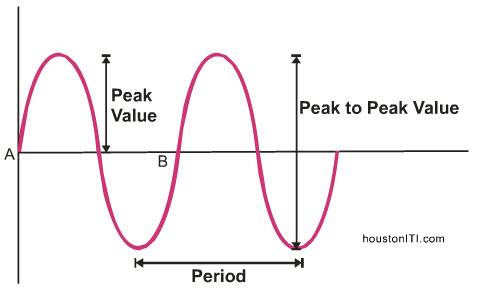 |
Alternating Current
In the DC circuits - the circuits we studied so far - the current has a steady value. That means when we said 5 amps, we meant that current of steady 5 amps will flow through circuit. Not so in the case of alternating current. In the case of alternating current, the current goes and down - even begins to flow in the reverse direction also. We refer to the current flowing in the reverse direction as negative current.
The current follows a sinusoidal path or a sine wave. To learn alternating current it is important we understand the characteristics of a sine wave and what it means in a practical sense.
Characteristics of a Sine Wave
The figure shown here shows a typical AC wave. The wave goes in cycles. One cycle extends from A to B. Notice that at B, the wave starts to repeat its motion. Notice that in each direction, positive and negative, it reaches a peak, then recedes back to zero. The definition of "peak value" is illustrated in the figure provided here.
Electric power goes through sixty of these cycles every second. We refer to this as “60 Hertz” or “60 Hz”. We call it the frequency of the wave.
The term “wavelength” simply gives the length of the wave. You can measure the wave length if you measure the distance between two peaks or any two identical points in the wave.
“Peak” value gives the value of voltage (current) from the zero point to the top most point of the wave.
“Period” is the time taken for one complete wave.
Mathematical relationship between period and frequency is given by the following formula:
Frequency x Period = 1
In this equation, frequency is given in hertz and period is given in seconds.
Example
Find the period of a sine wave if its frequency is 50 Hz.
Solution
Frequency x period = 1
Using the above formula we get: 50 x period = 1
Therefore period = 1/50 = 0.02 sec.